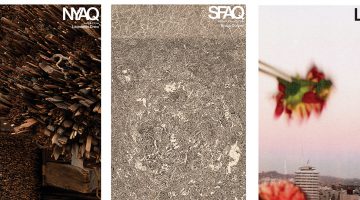The artists in Digital Infinity a group show at Jessica Silverman gallery on view thru August 3rd, tackle the difficult idea of presenting virtual digital space on analog media in real shared space.
The title Stack Overflow by Sean Raspet refers to a software issue where a lack of address space and available memory can lead to a program crash. The piece itself is a steel shelving unit supporting three plexiglass cubes, in the cubes suspended vertically in gel are laminated inkjet prints. The images printed on the paper are obscured by the space available, being too close together they are impossible to take in individually. That visual inaccessibility is a paradox, a kind of observational program crash What does the viewer pay attention to? The architectural space occupied by the shelves or the sculptural space of the cubes? The fact of the multiple inkjet prints or sussing out their obscured imagery? This intentional confusion, despite the physicality of the work, renders the piece ephemeral both inviting and rejecting the need to be looked at more.
Seven thousand five hundred individual inkjet prints arranged in three discrete paper obelisks comprise Aleksandra Domanovic’s Untitled (Marina-Lucica). The pieces of paper are modest echos and inversions of Andre’s plates reserving the space immediately above each piece for the next piece until a sculpture is formed, as well as reserving their obscured surfaces. Surfaces evacuated of marks but with bits of information printed at the edges so the images seem cast upon the sculptural space of the obelisks, resolving when the pages are stacked in these piles in this order. The images reference memory both personal and cultural and perhaps to our entrusting of memories to outside (digital) media. As we blithely abdicate memory to the virtual spaces of the internet, where they only seem to be seen, how will they come back to us and in what order?

Carter Mull, Hearts of Gold, Variable format video, not yet dated
With Special thanks to Chebo and Alanna Pearl. Courtesy of the gallery and artist.
Watch the video above here.
The surfaces of Carter Mull’s paintings are incidental not that they’re unimportant but that they are the incident through which the artist focuses our attention. Through this window is a chaotic space that contains illusion but not traditional realism, depth but not perspective. In this way it comes closest to being a visual analogue for the nonhierarchical way digital visual space is organized. We are all busy lookers constantly taking pictures and checking for updates. By using digital manipulation, analog means and handwork the artist present each of these things is equally important: a holographic image an analog drawing digitally printed out a pattern background with a heightened color palette. In real space our brain sorts and interprets what our eyes see, lending it a hierarchy we have used to find food and organize ourselves. Virtual space is a simulation of this and it’s speed fragments our perception just the way these compositions do. Carter Mull is not focused on flatness or depth, but the immersiveness of our contemporary visual experience.
For more information visit here.
Contributed by Matthew Marchand




